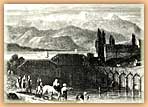 |

The question of land ownership in the Greek state and of the management of the National Estates remained practically unresolved until the agrarian reforms of 1871. During the Koumoundouros administration and with the assistance of the Finance Minister Soterios Soteropoulos, a law was drawn up and promulgated concerning the distribution of 265,000 hectares in 357,217 lots. Thus, the majority of farmers became the owners of the land they had cultivated. The reform concerned the National Lands and the people who had cultivated them and not the large ownerships in the regions of Attica, Euboea and Eastern Sterea. These latter had been left behind by Muslims after their delayed departure from the area in 1830 and the sale of their properties.
The small landowners specialized in profitable export crops (currants, tobacco, cotton). The Greek economy benefited from the exports of agricultural produce in many ways; the inflow of foreign exchange increased and so did the public revenues from custom duties levied on exports. Simultaneously, the production of grain fell and as a result large quantities of grain had to be imported. However, the specialization of production in only a few exportable products made the economy particularly vulnerable to international fluctuations, such as the currant crisis at the end of the 19th century.
|
 |